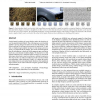Free Online Productivity Tools
i2Speak
i2Symbol
i2OCR
iTex2Img
iWeb2Print
iWeb2Shot
i2Type
iPdf2Split
iPdf2Merge
i2Bopomofo
i2Arabic
i2Style
i2Image
i2PDF
iLatex2Rtf
Sci2ools
SIGGRAPH
2010
ACM
2010
ACM
Apparent display resolution enhancement for moving images
Limited spatial resolution of current displays makes the depiction of very fine spatial details difficult. This work proposes a novel method applied to moving images that takes into account the human visual system and leads to an improved perception of such details. To this end, we display images rapidly varying over time along a given trajectory on a high refresh rate display. Due to the retinal integration time the information is fused and yields apparent super-resolution pixels on a conventional-resolution display. We discuss how to find optimal temporal pixel variations based on linear eye-movement and image content and extend our solution to arbitrary trajectories. This step involves an efficient method to predict and successfully treat potentially visible flickering. Finally, we evaluate the resolution enhancement in a perceptual study that shows that significant improvements can be achieved both for computer generated images and photographs. CR Categories: I.3.3 [Computer...
Computer Graphics | Limited Spatial Resolution | Refresh Rate Display | SIGGRAPH 2010 | fine Spatial Details |
| Added | 28 Jul 2010 |
| Updated | 29 Jul 2010 |
| Type | Conference |
| Year | 2010 |
| Where | SIGGRAPH |
| Authors | Piotr Didyk, Elmar Eisemann, Tobias Ritschel, Karol Myszkowski, Hans-Peter Seidel |
Comments (0)

